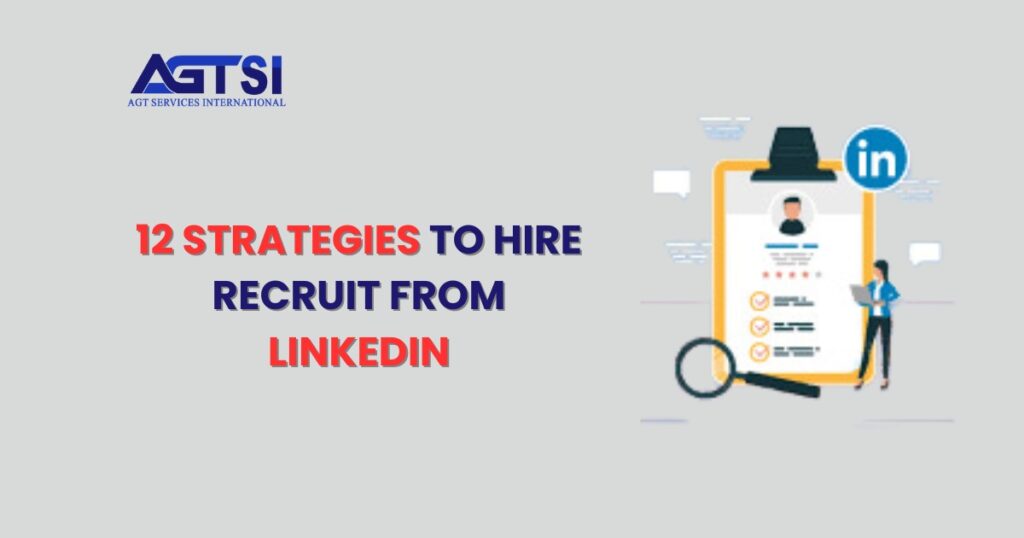Introduction
LinkedIn, with 55 million companies and 14 million jobs, is a top choice for recruiters. The hire through LinkedIn guide covers how to actually hire on LinkedIn by optimizing the company page, using search filters, hiring passive candidates, joining groups, posting job ads, and using LinkedIn Recruit Right Strategies. It also highlights the benefits of employee testimonials, referral programs, tracking metrics, staying active, employee backing, and personalized communication to attract and hire top talent.
12 LinkedIn Recruit Right Strategies
1. Join relevant LinkedIn groups
LinkedIn groups are like online hubs for professionals with recruiters professional interests. Recruiters share content, make connections, and often post job opportunities. To get the most out of these LinkedIn groups, it’s important to actively engage with job seekers. By joining relevant groups, recruiters can expand their network, stay updated on industry news, and even find potential candidates for job openings.
2. Share Job Openings on LinkedIn
LinkedIn groups are virtual communities where professionals like recruiters with similar interests gather together to share content, connect, and sometimes advertise job openings. To fully benefit from such LinkedIn groups, active participation is key. Grouping means engaging in discussions, sharing insights, and connecting with other members. By joining relevant groups, recruiters not only expand their network but also stay informed about industry news and trends. Additionally, LinkedIn groups can be a valuable resource for finding potential candidates for job vacancies within any organization. In essence, participating in LinkedIn groups offers a way to connect with like-minded professionals, stay updated, and discover talent.
3. Enable Candidates to Apply for Jobs through LinkedIn
Make it effortless for candidates to apply to job postings on LinkedIn by using the ‘Easy Apply’ feature. The tool allows applicants to submit their applications easily, often with just a click, especially if their resume is already on LinkedIn. Such a user-friendly process encourages more applicants to show interest in positions, making recruitment smoother for both job seekers and recruiters. With ‘Easy Apply,’ applicants can express interest in opportunities hassle-free, increasing the chances of finding the right fit for your team.
4. Search for passive candidates
Connecting with Passive Candidates on LinkedIn
LinkedIn is a great place to find people who aren’t actively looking for jobs. About 70% of workers worldwide fall into the passive candidates category. Applicants might not be job hunting, but they could be perfect for recruiting teams.
Growing Your List of Potential Hires
Look for professionals in roles similar to the ones the team is hiring for. Adding them to the list means recruiters have a bunch of qualified folks ready to consider when new opportunities arise in the company.
5. Search for Candidates by Keywords
Review job listings from various companies and take note of the keywords they use to attract applicants. Teams should incorporate keywords into their own job descriptions and utilize them when searching on platforms like LinkedIn. Keyword strategy enables the identification of candidates whose profiles align with company requirements swiftly and effectively, streamlining the hiring process. By using relevant keywords, you increase the likelihood of finding qualified candidates who fit company needs.
6. Use Your Pool of Talent
Recruiters should stay in touch with candidates by utilizing LinkedIn Recruit Right Strategies (LinkedIn) as a tool for ongoing communication. Candidates engaged and informed about potential future opportunities, recruiters can develop strong relationships and promote a continuous pool of talent. Regular updates, networking, and personalized interactions help to maintain interest and ensure that candidates remain invested in potential job opportunities within the organization. A proactive approach not only encourages a sense of connection but also positions recruiters to quickly access a qualified talent pool when new positions become available.
7. Find Candidates on LinkedIn with Boolean Search
Advanced Search:
- Utilize LinkedIn Recruit Right Strategies for enhanced search capabilities.
- Filter candidates by connections, location, current and past companies, industries, etc.
Upgrading to Premium Plans:
- Consider upgrading to LinkedIn Recruit Right Strategies for access to additional filters.
- Premium plans offer filters like job titles, skills, education, and expected salary.
Boolean Search:
- Employ Boolean search techniques to refine candidate searches.
- Use specific keywords and combinations for more precise results.
RECOMENDED: 10 Practical Steps to Increase Recruiter Productivity
8. Template Outreach to Candidates
Recruiters are usually busy, so they cannot send personalized messages to applicants on LinkedIn. To make things easier and get more responses, using ready-made message templates is important. These templates let companies create messages quickly, saving time and making sure your communication is consistent, no matter the role or stage of recruitment. By having these templates on hand, recruiters can reach out to candidates more efficiently and maintain a professional image. Additionally, templates can be customized to suit different types of roles and candidates, further facilitating the recruitment process.
9. Add Candidates with Recruitment Software
Recruiterflow ATS offers creative tools to make hiring faster and easier. Using its Chrome extension, recruiters can add candidates from social media platforms with just one click, automatically updating their dashboard. Additionally, Recruiterflow allows companies to post job listings, keep track of candidates, send emails, run campaigns to nurture relationships, schedule interviews, and create scorecards to evaluate candidates. Recruitment Software provides an all-in-one platform that streamlines the hiring process, saving time and effort for recruiters while ensuring a smooth experience for both candidates and hiring teams. Plus, its user-friendly interface makes it simple to manage every aspect of recruitment efficiently.
10. Ask for Referrals
Recruiters can ask colleagues and friends to suggest people for job positions. Recruiters can even post messages on platforms like LinkedIn asking for recommendations. Creating a culture where people refer candidates can help to find great talent consistently. Consider offering rewards or recognition for successful referrals to encourage more participation. Referrals not only grow the pool of potential hires but also strengthen the professional network. By tapping into the networks of employees and connections, recruiters can increase their chances of finding the right candidates for the team.
RECOMENDED: 13 Techniques for Building Employee Empowerment include
11. Monitor Competitor Activity
Recruiters can keep an eye on competitors’ company pages to see how they interact with their followers and find potential candidates. Look at what competitors post, how often competitors post, and how engaged their audience is to get ideas for improving their own hiring tactics. By monitoring competitor activities, recruiters can learn from competitor successes and apply similar strategies to attract top talent to recruiters’ own organizations. Additionally, observing competitors’ pages can help recruiters stay updated on industry trends and benchmark recruitment efforts against theirs. By monitoring, recruiters can remain competitive and continuously refine recruitment approaches to stay ahead in the market.
12. Provide Value Before Asking
Recruiters share useful information and insights with the network to establish trust and showcase expertise. When recruiters approach them about job opportunities. Regularly sharing tips and industry news and engaging with comments helps recruiters stay connected with their network and keeps you top-of-mind when they think of job openings. Additionally, actively participating in discussions and providing valuable input demonstrates recruiters’ knowledge and commitment to their field, further enhancing credibility and maintaining relationships within recruiters’ professional network. When they do reach out about job opportunities, they are more likely to receive energetic responses.
Conclusion
In short, these strategies offer key insights for recruiters hiring through LinkedIn Recruit Right Strategies. By joining relevant groups, sharing job openings, and simplifying applications, recruiters attract talent efficiently. Utilizing advanced search and engaging with passive candidates enhances the process. Monitoring competitors and providing valuable content keep recruiters ahead. With these strategies, recruiters optimize LinkedIn Recruit Right Strategies hiring and secure top talent.




















